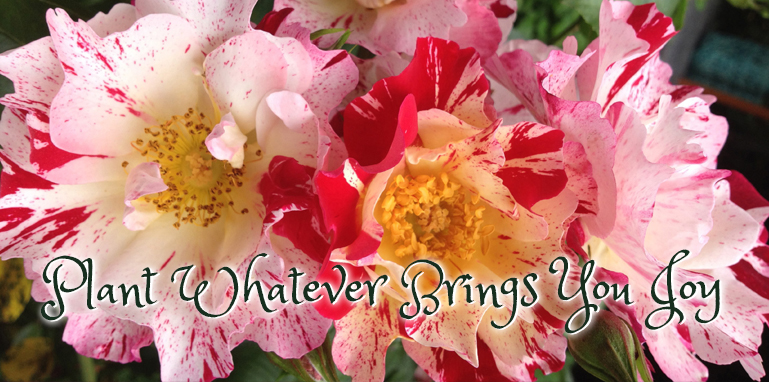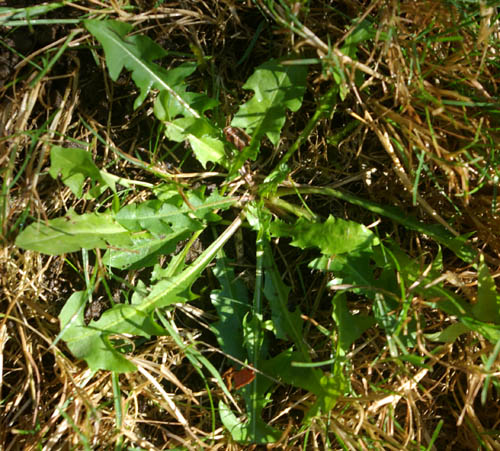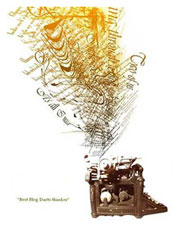Not so very long ago I noticed a large-leaved plant growing just in front of the ample bank of lavender that graces the front garden every summer, always very full of bees. What is that? I asked myself. A romaine? For several days after I continued to ponder this question as I sprayed the lavender early in the mornings prior to Bee Time. I’d already made the decision not to pull it up, and relished imagining how it had come to plant itself in the lawn. Did a bird bring it? Birds didn’t generally frequent the lavender, but it was possible. Or a squirrel? I loved considering the possibilities. In any case I wanted to hearken to my own advice, per one of the lessons in Plant Whatever Brings You Joy: “Never pull and discard what you cannot identify.” So there it stood. And grew. And grew. Huh.

Synchronistically the following Tweet caught my eye:
Americans today spend forty billion dollars annually on lawn care, and a hefty part of that budget goes to the attempt to eradicate dandelions.
Wow. Was that possible? Already bearing mixed feelings on the whole Lawn Thing, I followed a link to a piece published in Seattle that sourced the quote being from a book titled The Teeth of the Lion: The Story of the Beloved and Despised Dandelion. Intrigued I ordered a copy.
Meanwhile, while waiting for the book to arrive I began reevaluating the identity of my mystery “lettuce.” Was it possible this was a dandelion?? It certainly bore resemblance to the leaves sported on the cover of the book I was awaiting! Yet, I expected dandelion to look like this:
Now fully engaged in this discovery process, I began watering the little dandelion to see if it might eventually emerge like the “big one.” I didn’t have to wait. One morning I came out and the Big Dandelion flaunted the answer.
Still, I remain puzzled by the discrepancy and am now committed to growing dandelions in my garden especially after reading Anita Sanchez’s splendid book on a very thorough engaging and fascinating look at the history of the dandelion over many many centuries and terrains. What an excellent and invaluable treatise! For who knew that the early pioneers brought dandelions with them as a matter of course for their first gardens and that they were a highly valued medicinal resource, as well as valued as a salad green? Not I. Then Anita enchantingly traces the path of the hearty and determined and opportunistic dandelion seed as it makes its way ever westward in the treads left by the wagons of the pioneers, apparently perfectly designed as a plant to embed itself, lying flat and protected in the mud, emerging under the last snow as one of the first greens. Fascinating!
Dandelion’s first use was recorded in China in the seventh century. In the eleventh century the Arabs promoted its use, and by the sixteenth century it was well established throughout Europe.
Fastforward to modern times that reveal the nutritional value of the common, abundant and unappreciated dandelion:
Dandelions are a vitamin powerhouse: 100 grams of raw dandelion greens have 14,000 international units of Vitamin A, plus 35 milligrams of ascorbic acid, or Vitamin C. That’s more Vitamin C than tomatoes, and seven times the Vitamin A of oranges, pound for pound. In addition, dandelions have significant amounts of protein, iron, thiamine, riboflavin, calcium, and potassium, as well as vitamins D, K, and B-complex.
And we are spending our hard earned money on killing them. So sad.
I want to interject a little side story here. I recently had a chat with an old friend of mine, a rather elderly black man who was raised in Virginia. I told him about my dandelion lesson and he shared with me that when he was a little boy they “never paid for greens.” They went out into the woods and collected all they needed, for free. For seventy plus years ago you could do that in Virginia. What a blessing, gone astray.
The Teeth of the Lion will take you on a journey far beyond what you might expect from a small book about dandelions. By using the simple dandelion as a microcosmic lens Anita Sanchez opens the door to the macrocosmic world of plants in general. As Senior Environmental Educator at the New York Dept. of Environmental Conservation’s Five Rivers Environmental Education Center in New York, she is perfectly poised to take us on this exquisite and unexpected tour of the plant world. It is highly advised.
Enjoy.
Love and garden blessings,
Kathryn xoxox
Footnote! Learned this week: Health food stores and seed companies are selling seeds for “Italiko Rosso dandelion” or “Italiko Rosso chicory”. They are selling the product as a “dandelion.” Again, dandelion is Taraxacum officianale. Italiko Rosso is a chicory and it’s formal name is Cichorium intybus. Duly noted!
Book News: I am so thrilled to report that the Unity Church in Seattle and Boulder Books in Boulder, CO will be making copies of Plant Whatever Brings You Joy available to their customers! Many thanks to their buyers!
If you find this blog of interest I hope you will consider purchasing a copy of Plant Whatever Brings You Joy: Blessed Wisdom from the Garden. Actual books are available at Estrella Catarina. The Kindle version is available in the US, the UK and in Germany in the Kindle store.
Posted on August 4th, 2011 by Kathryn
Filed under: Book Notes















Great post, mom! I have heard that dandelion greens are incredibly good for us. I think it’s wonderful you’ve introduced this information! Brava!
Love you,
Antonia
xoxo
Hi, Antonia! I ate one of the leaves. Then I walked around hoping it really was a dandelion. (This was pre-flower!) I did read in Anita’s book there’s nothing known to mimic dandelion that would be poisonous. Still… 🙂 LOL!
Love, Mom xoxo
Ah, another wonderful treat from Kathryn…and I’m NOT talking about dandelions per se…but about having my consciousness-raised regarding another bit of nature I had no idea about.
Kathryn, after your last piece on that scooter-bug-thing, I let spiders “go” …just couldn’t deal with them in my usual manner; not after reading your sensitive observation & care of that little guy in the wading pool.
Appreciation for all manner of boosting new thinking, Kathryn…Thank you again !
Blessings,
~M~
Good morning, Marlene! Thank you so much for your kind acknowledgment. So appreciated! Your house spiders must be happy to find themselves back outside! I honestly pick and choose which ones go back outside and which ones go “back to God.” A black widow in my garden will not survive, I promise you. Nor a centipede. Most critters are safe in my garden and it does serve as sanctuary to all birds and butterflies (and, yes, pond skaters!) Kathryn xoxo
A constant source of information/joy … so enjoyed this, dear Kathryn. By chance, have you ever read Ray Bradbury’s Dandelion Wine? I so love this book! Happy August, dear friend 🙂
Hi, Joey! Thank you kindly for the visit. Glad you enjoyed the dandelion journey. 🙂 I am not familiar with that book. I will check it out! Summer hugs! Kathryn xoxo
Oh WOW, another book to add to my list, locate and add to my garden library. I love dandelions. I have long felt that if they were a lot harder to raise, they would be grown with pride in the most demanding of gardens. They are one of the most beautiful of the composite family of plants. I always let mine live but with as much shade as we have here, our crop is reducing year by year. As children, they were a special treat. Mom would send us out with small sharp knives and gathering pails to cut off the heads like harvesting a head lettuce or endive. They remind me a great deal like endive in taste. They had to be harvested before coming to bud, when the most fresh & young. She would make a hot bacon, cidar vinegar & onion wilting dressing (similar to a spinach dressing) and we’d have them with dinners for several weeks to a month or more in the spring. Of course, we had no fertilizer or herbicides added to the yard and we didn’t pick in the areas where the dogs spent most of their time, either. I hope many of your readers feel brave enough to try them in mixed greens early salads or on their own.
BTW, I’m still working on the John Muir book. It is slow reading but it’s wonderful science. I am blown away by his discoveries and his understandings of the mountain glacial processes long before these processes were common knowledge even in the field of geology. More when I finish it.
Hugs, Julie
Hi, Julie! Oh, you will love this book! I also hope readers will venture out to those areas where clean dandelions are growing. (No pesticides or fertilizers ever come into my front garden!) It does take a bit of courage if you’ve grown up believing they were simply “weeds”! Lucky you to have a mother who taught you their value early! May this book help bring them back! I’m saving my seeds! ~So glad you are enjoying the Muir book! Isn’t it amazing? Hugs! Kathryn xoxo
Dandelions are so common here in Spring — and much despised by most, I might add. Folks will go to great lengths to snap their little yellow heads off to discourage spreading. I, on the other hand, think they are the loveliest of the harbingers of spring and their sunny yellow is welcome. A word about eating the greens, for the tastiest salads, etc. eat the leaves before the plant flowers to avoid the bitterness. 🙂 (This carpet of yellow was taken in a field not far from where I live — many lawns look like this in mid-spring: http://nancybond.files.wordpress.com/2010/05/dandelions2.jpg)
Nancy, so good to hear from you! That photo is spectacular! I have NEVER seen such a sight down here in America. I wish I had. Imagine the beauty we are depriving ourselves of. That dandelion needs a good publicist! Your photo can be in the press kit! And thanks for the tender leaves tip! Hugs to you up there in Canada! Kathryn xoxo
Thanks Kathryn for reminding me how much I love dandelions! I live in Chicago now, and don’t see many dandelions amidst all the concrete (or perhaps I’m just not noticing, and now I will after reading this!). I grew up as a child in an area of lawns and fields, and I always thought the dandelions added a beautiful color against the green canvas of grass–a perfect combination. I remember all the crotchety adult neighbors being so undone at this “horrible eyesore” on their precious, well-manicured lawns.
The other reminder you inspired was hearing stories about when my grandmother was a little girl. Her father and his brothers, immigrants from Austria, would make dandelion wine with their secret homemade still in the basement. Once grandma’s sister heard a gurgling in the basement, went down and saw the contraption, and put the fire out, not knowing what it was. Of course she was in big trouble for ruining a perfectly good batch of dandelion wine.
Hi, Sean and welcome! I’m afraid those crotchety folks are still around! So glad you have that early childhood memory in store. The dandelion wine story is funny! I will have to research this dandelion wine. Never had it! Kathryn xoox
OK, so I searched out my old, old copy of Ray Bradbury’s “Dandelion Wine” which, besides being a magical book about a 12-year old boy’s summer in 1928, does discuss making dandelion wine with his grandparents. His grandfather was especially proud of the yellow carpet in his yard. The wine is made by picking young blossoms and then crushing them in a press that sounds something like a cider press & adding “pure” rain water (which I would not try today) and I suspect adding sugar & fermentation and then bottling the brew in old bottles. The discription is not real detailed. I don’t know if they used a brewer’s yeast or just trusted to the luck of the wild yeasts. The other discription from Sean sound more like a distillation process but maybe it was just heating the crush at some point. Our great-grandparents used to make wines out of all kinds of summer fruit & flowers. I’ve had red clover wine and any number of fruit wines, but I don’t remember dandelion wine. Let us know what you find in your research.
Hugs, Julie
Hi, Julie, Well now I’m going to have to go buy this book and read it! LOL!
Thanks for the dandelion wine recipe. Now I’m really curious! Yes, I’m sorting it all out and will post on the other side of the research! Baker Creek Seed Bank helping me out. Hugs to Ohio! Thanks for all your help, Julie! Kathryn xoxo